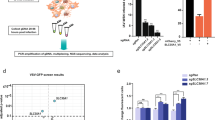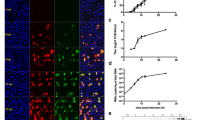Summary
Infection of L929 murine cells with vesicular stomatitis virus (VSV) results in inhibition of host protein synthesis and appearance of membrane alterations at a time when cells are still actively engaged in viral protein synthesis. VSV temperature-sensitive (ts) mutants have been used to explore the role(s) played by the virus-coded proteins in the genesis of these effects. Cells were infected with each of fivets mutants representing the known complementation groups of VSV Indiana serotype, and incubated at permissive (32 °C) and non-permissive temperatures (39 °C). Protein synthesis in the presence and absence of Hygromycin B (Hyg.B) was analyzed during virus infection via incorporation of35S-methionine in acid-precipitable material and SDS-polyacrylamide gel electrophoresis.
Data indicate that mutants belonging to groups I (L protein), II (NS protein) and IV (N protein) do not inhibit host protein synthesis and do not induce any membrane changes when grown at the non-permissive temperature. Mutants of group III (M protein) and V (G protein), instead, do inhibit cell protein synthesis and induce membrane changes also when grown at the non-permissive temperature; this suggests that these effects do not correlate with the biological activity of these proteins and their interaction with the cellular membrane. On the other hand, mutants exhibiting defective steps of nucleocapsid replication are apparently unable to induce these effects once more suggesting that virus replication per se is essential, as also indirectly shown by experiments employing cycloheximide to mimic shut-off.
Similar content being viewed by others
References
Bashford CL, Alder GM, Gray MA, Micklem KJ, Taylor CC, Turek PJ, Pasternak CA (1985) Ozonol dyes as monitors of membrane potential. The effects of viruses and toxins on the plasma membrane potential of animal cells in monolayer culture and in suspension. J Cell Physiol 123: 326–336
Benedetto A, Rossi GB, Amici C, Belardelli F, Cioe L, Carruba G, Carrasco L (1980) Inhibition of animal virus production by means of translation inhibitors unable to penetrate normal cells. Virology 106: 123–132
Cameron JM, Clemens MJ, Gray MA, Menzies DE, Mills BJ, Warren AP, Pasternak CA (1986) Increased sensitivity of virus-infected cells to inhibitors of protein synthesis does not correlate with changes in plasma membrane permeability. Virology 155:534–544
Carrasco L (1971) The inhibition of cell functions after viral infection. FEBS Lett 76: 11–15
Carrasco L, Esteban M (1982) Modification of membrane permeability in vaccinia virus-infected cells. Virology 117: 62–69
Carrasco L, Lacal JC (1983) Permeabilisation of cells during animal virus infection. Pharmacol Ther 23: 109–145
Carrasco L, Smith AE (1976) Sodium ions and shut off host cell protein synthesis by picornavirus. Nature 264: 807–809
Contreras A, Carrasco L (1979) Selective inhibition of protein synthesis in virus-infected mammalian cells. J Virol 29: 114–122
Edwards J, Brown DT (1986) Sindbis virus mediated cell fusion from without is a two-step event. J Gen Virol 67: 377–380
Garry RF, Bishop JM, Parker S, Westerook K, Lewis G, Wate MRF (1979) Na+ and K+ and the regulation of protein synthesis in Sindbis virus-infected chicken cells. Virology 96: 121–128
Garry RF, Bostick DA, Ulug ET (1986) Sindbis virus infection increases hexose transport in quiescent cells. Virology 155: 378–391
Garry RF, Ulug ET, Bose HR (1982) Membrane mediated alterations in intracellular Na+ and K+ in lytic virus-infected and retrovirus-transformed cells. Biosci Rep 2: 617–623
Gonzales A, Jimenez A, Vasquez D, Daviez JE, Schindler D (1978) Studies on the mode of action of hygromycin B, and inhibitor of translocation in eukaryotes. Biochem Biophys Acta 512: 459–469
Hughes JV, Johnson TC, Rabinowitz SG, Dal Canto MC (1979) Growth and maturation of vescicular stomatitis virus temperature-sensitive mutant and its central nervous system isolate. J Virol 29: 312–321
Knipe DM, Baltimore D, Lodish HF (1977) Analysis of defects of temperature-sensitive mutants of vesicular stomatitis virus: intracellular degradation of specific viral proteins. J Virol 21: 1140–1148
Knipe DM, Baltimore D, Lodish HF (1977) Maturation of viral proteins in cells infected with temperature-sensitive mutants of vesicular stomatitis virus. J Virol 21: 1149–1158
Impraim CC, Foster KA, Micklem KJ, Pasternak CA (1980) Nature of virally-mediated changes in membrane permeability to small molecules. Biochem J 186: 847–960
Laemmli UK (1970) Cleavage of structural proteins during the assembly of the head of bacteriophage T4. Nature 227: 680–682
Levanov A, Kohn A, Ineae M (1977) Increase in lipid fluidity of cellular membranes induced by adsorption of RNA and DNA virions. J Virol 22: 358–360
Lodish HF, Weiss RA (1979) Selective isolation of mutants of vesicular stomatitis virus defective in production of the viral glycoprotein. J Virol 30: 177–189
Marvaldi JL, Lucas-Lenard J, Sekellick MJ, Marcus PI (1977) Cell killing and protein synthesis inhibition by vesicular stomatitis virus require the same gene functions. Virology 79: 267–280
Nozawa CM, Apostolov K (1982) Association of the cytophatic effect of Sindbis virus with increased fatty acid saturation. J Gen Virol 59: 219–222
Pringle CR (1977) Genetics of rhabdoviruses. In: Wagner RR, Fraenkel-Conrad H (eds) Comprehensive virology, vol 9. Plenum Press, New York, pp 239–289
Schnitzer TJ, Lodish HF (1979) Noninfectious vesicular stomatitis virus particles deficient in the viral nucleocapsid. J Virol 29: 443–447
Ulug ET, Garry RF, Wate MRF, Bose HR Jr (1984) Alterations in monovalent cation transport in Sindbis virus-infected chicken cells. Virology 122: 118–130
Unger JT, Reichmann ME (1973) RNA synthesis in temperature-sensitive mutants of vesicular stomatitis virus. J Virol 12: 570–578
Wilcox DK, Whitaker-Dowling PA, Younger JS, Widnell CC (1983) Rapid inhibition of pinocytosis in baby hamster kidney (BHK-21) cells following infection with vesicular stomatitis virus. J Cell Biol 97: 1444–1451
Author information
Authors and Affiliations
Additional information
This work was supported in part by grant from Consiglio Nazionale delle Ricerche, Rome, Italy, No. 85.00842.04 (Gruppo di Virologia).
Rights and permissions
About this article
Cite this article
di Francesco, P., Sorrentino, V., Battistini, A. et al. L929 cells infected with temperature sensitive mutants of vesicular stomatitis virus: virus replication is necessary for induction of changes in membrane permeability. Archives of Virology 97, 225–236 (1987). https://doi.org/10.1007/BF01314423
Received:
Accepted:
Issue Date:
DOI: https://doi.org/10.1007/BF01314423




